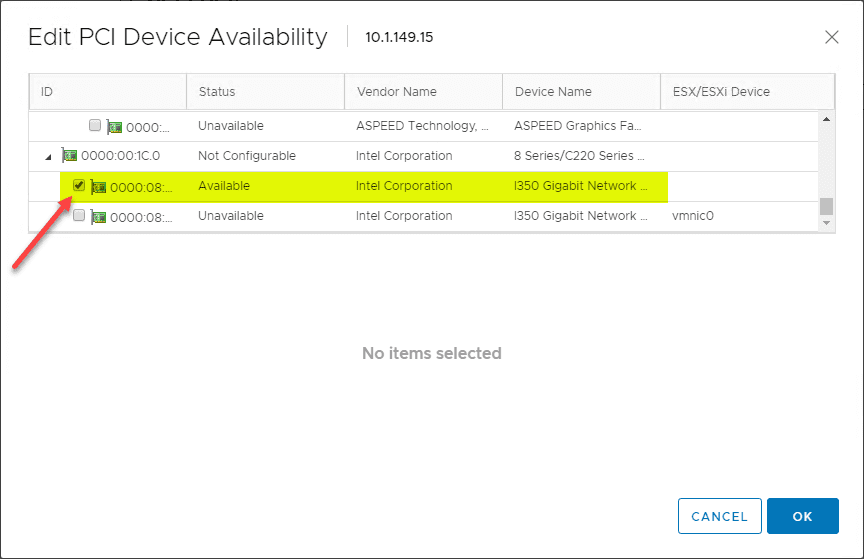

- Pass through a physical hdd to a vm esxi 6.5 how to#
- Pass through a physical hdd to a vm esxi 6.5 pro#
You'll have to click on the drop down and select e.g. Hard disk 2, expand it and make sure it's using the newly created SCSI controller.
Once the HDD is created, under the new disk e.g. You'll have to use the Datastore file browser to select the HGST_RDM_1.vmdk file Under Add hard disk, click Existing hard disk and select the newly created vmdk file. In other words, you can reuse the controllers. Under Add other device, click SCSI controller (If you already have an existing SCSI controller for RDMs, you don't need to create another one). Go back to the web app, go to the Virtual Machine, and click Edit. See ĭo not name your RDM's with -rdm in the end of the name or you'll receive error The value was rejected by rule "Virtual SCSI or NVMe Devices". It has to ben an existing store or else you get error Failed to create virtual disk: The system cannot find the file specified (25). Pass through a physical hdd to a vm esxi 6.5 pro#
In my case, Samsung 850 Pro is simply the datastore name I wrote to be self descriptive. You should cd /vmfs/volumes/ and ls around to find the right virtual disk. The folder structure is in this format: /vmfs/volumes/DATASTORE/VIRTUAL_DISK/ The VIRTUAL_DISK should be the name of the virtual disk you're using in your VM, for me it's called Ubuntu Storage. vmfs/volumes/Samsung 850 Pro/Ubuntu Storage/ folders. vmdk files can only mount in virtual disk folders. Vmkfstools is attaching the physical disk and mapping it to a vmdk file. Make sure you read Prerequisite knowledge section about datastores, and virtual disks first. # vmkfstools -z /vmfs/devices/disks/t10.ATA_HGST_HDN726050ALE610_NAG4P4YX_ "/vmfs/volumes/Samsung 850 Pro/Ubuntu Storage/HGST_RDM_1.vmdk" There will be other listings here of datastores, and virtual disks that is not relevant. Here I have a HGST 5TB disk attached to SATA that I'm trying to passthrough to my VM. You can determined the name/path by going to the web console then Storage, then Device, click on the device you're setting up as RDM, and then copying the path. As mentioned in the comments, it may not necessarily start with t10. We care about the physical disks with the prefix t10.
Run this command to list the disks that are attached to the ESXi host:. Click on Actions > Services > Enable Secure Shell (SSH). In EXSI's web interface, log in, go to the home page. In my example, I have a virtual machine and virtual disk both conveniently named Ubuntu Storage RDMs on EXSI 6.5 have to be created in the command line.īefore you get started, make sure you've got a VM setup, and running. RDM aka Raw Device Mapper is a pointer file that acts like a virtual disk but instead maps directly to a physical disk. In other words Physical Disk > Datastore > Virtual Disks > Your filesystem e.g. Virtual disks are what a virtual machine will stores files on. A datastore can max the storage of a physical disk, or not. A Datastore is basically this separate layer that sits between a physical device/disk and a virtual disk. If you're new to EXSI, you should know a few things: We attach the SATA HDDs as a RDM (Raw Device Mapper) into an existing virtual disk in the command line, then on the web app, we attach a new SCSI controller to the VM, and attach the newly created RDM as an "existing HDD" to the newly created SCSI controller. I have not personally tried it yet, but the comments below have confirmed it works. There is now an option while editing your VM's settings to add a New raw disk when you click Add hard disk. This tutorial is partially based on VMWare's own KB and the now deprecated Forza IT blog post. Pass through a physical hdd to a vm esxi 6.5 how to#
This tutorial shows you how to pass SATA HDDs to the virtual machine on VMWare ESXI 6.5. You used to be able to setup RDMs in the desktop client, but with the introduction of the web console, this is no longer the case. In v6.5, the web app was introduced and the desktop client was deprecated. There aren't many tutorials about this, the only tutorials I've found were about passing through entire PCIe cards to VMs, or refered to old ESXI versions (below 6.5) that used a more comprehensive desktop client instead of the web app. How to passthrough SATA drives directly on VMWare EXSI 6.5 as RDMs





 0 kommentar(er)
0 kommentar(er)
